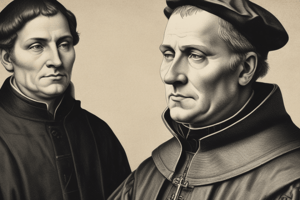Podcast
Questions and Answers
What centers on practices within the Catholic Church regarding baptism and absolution?
What centers on practices within the Catholic Church regarding baptism and absolution?
95 Theses
What was the aim of the Inquisition?
What was the aim of the Inquisition?
- To establish new religious sects
- To promote heresy
- To sell indulgences
- To combat heresy (correct)
Who was a seminal figure of the Protestant Reformation?
Who was a seminal figure of the Protestant Reformation?
Martin Luther
When is the start of the Protestant Reformation considered to be?
When is the start of the Protestant Reformation considered to be?
What initiated the Counter-Reformation?
What initiated the Counter-Reformation?
What four major elements composed the Counter-Reformation?
What four major elements composed the Counter-Reformation?
Flashcards are hidden until you start studying
Study Notes
95 Theses
- Crafted by Martin Luther, it criticizes Catholic practices, particularly regarding baptism and absolution.
- Emphasizes a profound rejection of indulgences, which allowed remission of sins for monetary payments.
- Argues that indulgence sales misrepresent true confession and penance, reducing spiritual transactions to financial dealings.
The Inquisition
- Established to combat heresy within the Roman Catholic Church, beginning in 12th-century France.
- Initially targeted groups like the Cathars and Waldensians, later including the Hussites and Spiritual Franciscans.
- Dominicans were commonly appointed as inquisitors, replacing local clergy; this period is known as the Medieval Inquisition.
Martin Luther
- Key figure in the Protestant Reformation, he was a German friar, Catholic priest, and theology professor.
- Strongly opposed the notion that sin could be absolved through money, challenging the practices of indulgence sellers.
- Faced excommunication and outlaw status after refusing to recant his writings at the Diet of Worms in 1521.
Protestant Reformation
- Initiated by figures like Martin Luther and John Calvin, marking a significant split in Western Christianity.
- It began in 1517 with the publication of the Ninety-Five Theses, criticizing the sale of indulgences and asserting salvation through faith alone.
- The movement expanded to challenge various Catholic doctrines, culminating in the Peace of Westphalia in 1648, which ended the Thirty Years' War.
Counter Reformation
- A Catholic revival initiated in response to the Protestant Reformation, spanning from the Council of Trent (1545-1563) to the conclusion of the Thirty Years' War.
- Comprised four key elements: ecclesiastical reformation, religious orders, spiritual movements, and political actions.
- Enacted reforms included the establishment of seminaries for priest training and efforts to return religious orders to their spiritual foundations.
- Introduced new spiritual movements focusing on devotion and personal relationships with Christ, along with activities such as the Roman Inquisition.
Studying That Suits You
Use AI to generate personalized quizzes and flashcards to suit your learning preferences.




